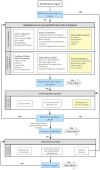Review of rehabilitation protocols for brachial plexus injury
- PMID: 37139070
- PMCID: PMC10150106
- DOI: 10.3389/fneur.2023.1084223
Review of rehabilitation protocols for brachial plexus injury
Abstract
Brachial plexus injury (BPI) is one of the most serious peripheral nerve injuries, resulting in severe and persistent impairments of the upper limb and disability in adults and children alike. With the relatively mature early diagnosis and surgical technique of brachial plexus injury, the demand for rehabilitation treatment after brachial plexus injury is gradually increasing. Rehabilitation intervention can be beneficial to some extent during all stages of recovery, including the spontaneous recovery period, the postoperative period, and the sequelae period. However, due to the complex composition of the brachial plexus, location of injury, and the different causes, the treatment varies. A clear rehabilitation process has not been developed yet. Rehabilitation therapy that has been widely studied focusing on exercise therapy, sensory training, neuroelectromagnetic stimulation, neurotrophic factors, acupuncture and massage therapy, etc., while interventions like hydrotherapy, phototherapy, and neural stem cell therapy are less studied. In addition, rehabilitation methods in some special condition and group often neglected, such as postoperative edema, pain, and neonates. The purpose of this article is to explore the potential contributions of various methods to brachial plexus injury rehabilitation and to provide a concise overview of the interventions that have been shown to be beneficial. The key contribution of this article is to form relatively clear rehabilitation processes based on different periods and populations, which provides an important reference for the treatment of brachial plexus injuries.
Keywords: brachial plexus injury; neonatal brachial plexus injury; neuropathic pain; rehabilitation; treatment.
Copyright © 2023 Li, Chen, Wang, Zhang and Chen.
Conflict of interest statement
The authors declare that the research was conducted in the absence of any commercial or financial relationships that could be construed as a potential conflict of interest.
Figures


References
Publication types
LinkOut - more resources
Full Text Sources

